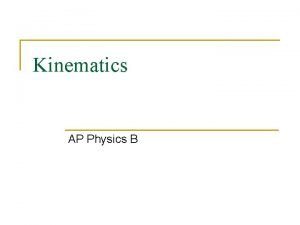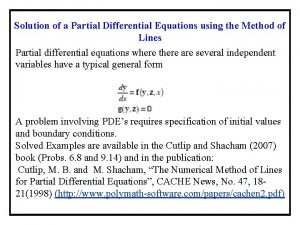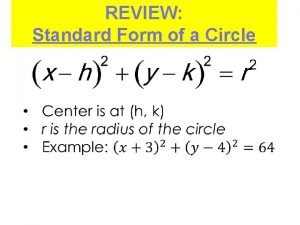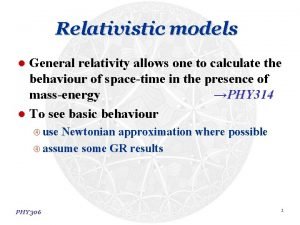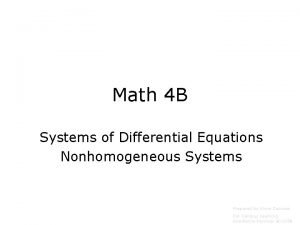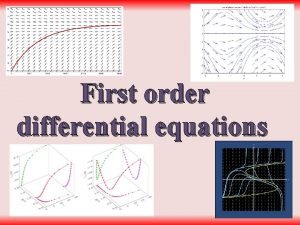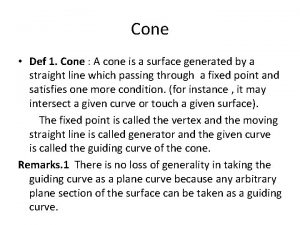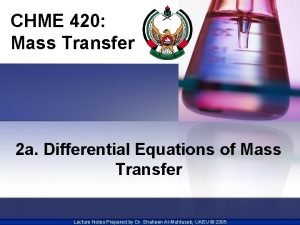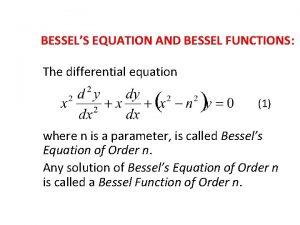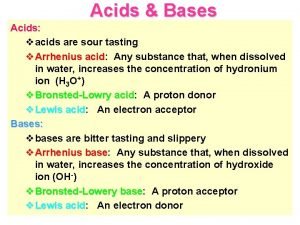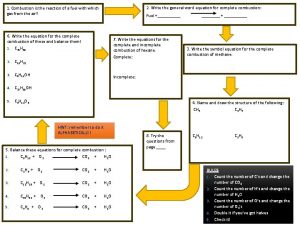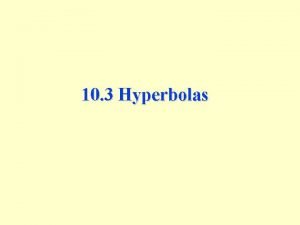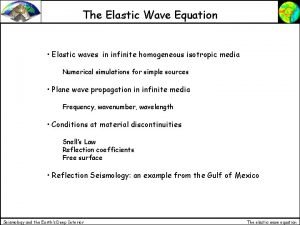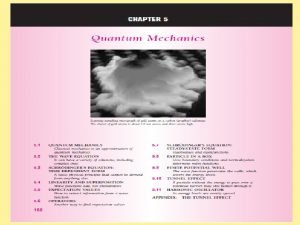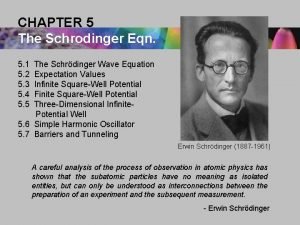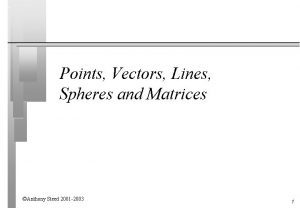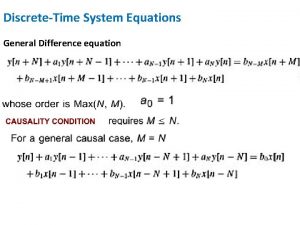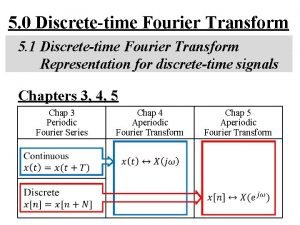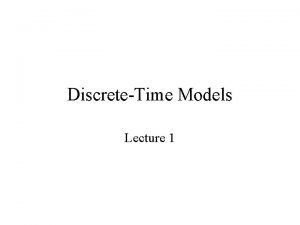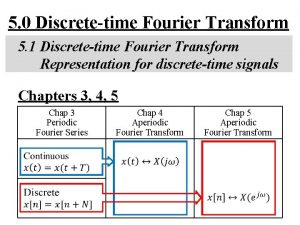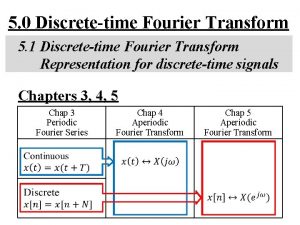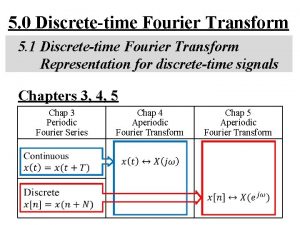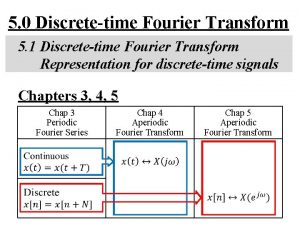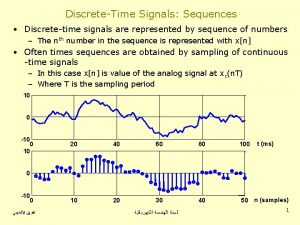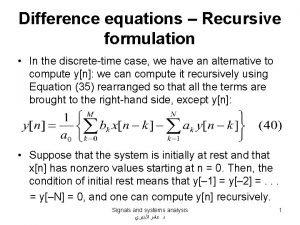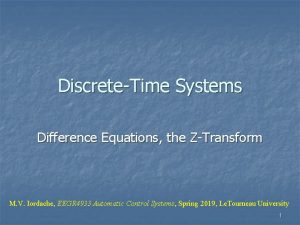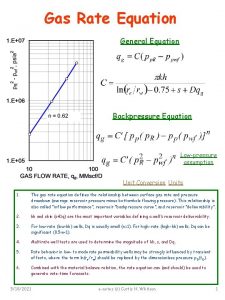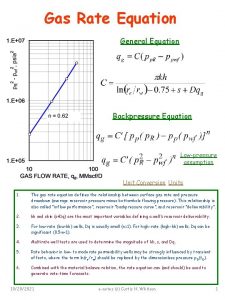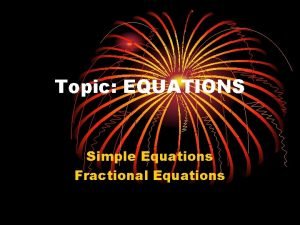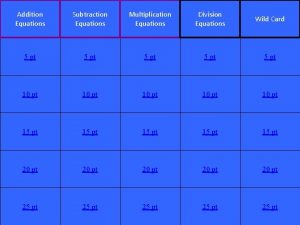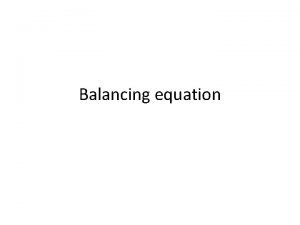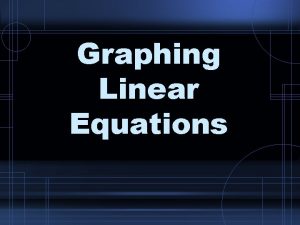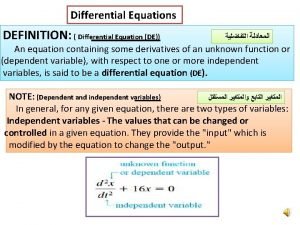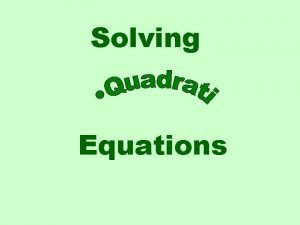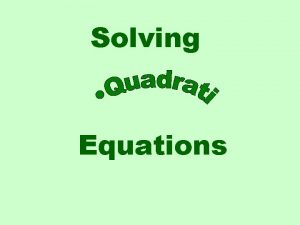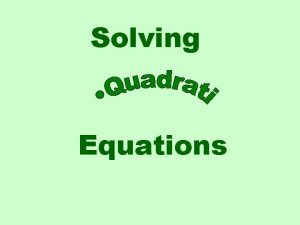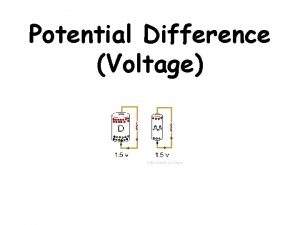DiscreteTime System Equations General Difference equation If we






![Ex [n] = x [n + 1] E 2 x [n] = x [n Ex [n] = x [n + 1] E 2 x [n] = x [n](https://slidetodoc.com/presentation_image_h2/7c4cf3b840f0d65f931efab0fe0e3e69/image-7.jpg)

![Q[E] y 0[n] = 0 The equation states that a linear combination of y Q[E] y 0[n] = 0 The equation states that a linear combination of y](https://slidetodoc.com/presentation_image_h2/7c4cf3b840f0d65f931efab0fe0e3e69/image-9.jpg)
![Therefore, if y 0[n] = cγ n we have Ey 0 [n] = y Therefore, if y 0[n] = cγ n we have Ey 0 [n] = y](https://slidetodoc.com/presentation_image_h2/7c4cf3b840f0d65f931efab0fe0e3e69/image-10.jpg)



![The Unit Impulse Response h[n] Q[E] y[n] = P[E] x[n] The unit impulse response The Unit Impulse Response h[n] Q[E] y[n] = P[E] x[n] The unit impulse response](https://slidetodoc.com/presentation_image_h2/7c4cf3b840f0d65f931efab0fe0e3e69/image-14.jpg)
![The Unit Impulse Response h[n] • The Unit Impulse Response h[n] •](https://slidetodoc.com/presentation_image_h2/7c4cf3b840f0d65f931efab0fe0e3e69/image-15.jpg)
![The Unit Impulse Response h[n] • The Unit Impulse Response h[n] •](https://slidetodoc.com/presentation_image_h2/7c4cf3b840f0d65f931efab0fe0e3e69/image-16.jpg)
![The Unit Impulse Response h[n] • The Unit Impulse Response h[n] •](https://slidetodoc.com/presentation_image_h2/7c4cf3b840f0d65f931efab0fe0e3e69/image-17.jpg)
![The Unit Impulse Response h[n] • The Unit Impulse Response h[n] •](https://slidetodoc.com/presentation_image_h2/7c4cf3b840f0d65f931efab0fe0e3e69/image-18.jpg)
![Example Determine the unit impulse response h[n] for a system specified by the equation Example Determine the unit impulse response h[n] for a system specified by the equation](https://slidetodoc.com/presentation_image_h2/7c4cf3b840f0d65f931efab0fe0e3e69/image-19.jpg)


![System Response to External Input The Zero-State Response • The zero-state response y[n] is System Response to External Input The Zero-State Response • The zero-state response y[n] is](https://slidetodoc.com/presentation_image_h2/7c4cf3b840f0d65f931efab0fe0e3e69/image-22.jpg)






![Determine c[n] = x[n] ∗ g[n] for x[n] and g[n] both are causal because Determine c[n] = x[n] ∗ g[n] for x[n] and g[n] both are causal because](https://slidetodoc.com/presentation_image_h2/7c4cf3b840f0d65f931efab0fe0e3e69/image-29.jpg)

- Slides: 30

Discrete-Time System Equations General Difference equation If we put n = n -N





![Ex n x n 1 E 2 x n x n Ex [n] = x [n + 1] E 2 x [n] = x [n](https://slidetodoc.com/presentation_image_h2/7c4cf3b840f0d65f931efab0fe0e3e69/image-7.jpg)
Ex [n] = x [n + 1] E 2 x [n] = x [n + 2]. . . E N x [n] = x [n + N] For example y[n + 1] − ay[n] = x [n + 1] Ey[n] − ay[n] = E x[n] (E − a)y[n] = E x[n]

![QE y 0n 0 The equation states that a linear combination of y Q[E] y 0[n] = 0 The equation states that a linear combination of y](https://slidetodoc.com/presentation_image_h2/7c4cf3b840f0d65f931efab0fe0e3e69/image-9.jpg)
Q[E] y 0[n] = 0 The equation states that a linear combination of y 0 [n] and advanced y 0 [n] is zero not for some values of n but for all n. Such situation is possible if and only if y 0 [n] and advanced y 0 [n] have the same form. This is true only for an exponential function γ n+m = γ m γ n γn.
![Therefore if y 0n cγ n we have Ey 0 n y Therefore, if y 0[n] = cγ n we have Ey 0 [n] = y](https://slidetodoc.com/presentation_image_h2/7c4cf3b840f0d65f931efab0fe0e3e69/image-10.jpg)
Therefore, if y 0[n] = cγ n we have Ey 0 [n] = y 0 [n + 1] = cγ n+1 = c γ γ n E 2 y 0 [n] = y 0 [n + 2] = cγ n+2 = c γ 2 γ n. . . EN y 0 [n] = y 0 [n + N] = cγ n+N = c γ N γ n System response to Internal Conditions: The Zero-Input Response cont. Substitution of these results to the system equation yields



![The Unit Impulse Response hn QE yn PE xn The unit impulse response The Unit Impulse Response h[n] Q[E] y[n] = P[E] x[n] The unit impulse response](https://slidetodoc.com/presentation_image_h2/7c4cf3b840f0d65f931efab0fe0e3e69/image-14.jpg)
The Unit Impulse Response h[n] Q[E] y[n] = P[E] x[n] The unit impulse response h[n] is the solution of this equation for the input δ[n] with all the initial conditions zero; that is Q[E] h[n] = P[E] δ[n] …. . (I) subject to initial conditions h[-1] = h[-2] = · · · = h[-n] = 0
![The Unit Impulse Response hn The Unit Impulse Response h[n] •](https://slidetodoc.com/presentation_image_h2/7c4cf3b840f0d65f931efab0fe0e3e69/image-15.jpg)
The Unit Impulse Response h[n] •
![The Unit Impulse Response hn The Unit Impulse Response h[n] •](https://slidetodoc.com/presentation_image_h2/7c4cf3b840f0d65f931efab0fe0e3e69/image-16.jpg)
The Unit Impulse Response h[n] •
![The Unit Impulse Response hn The Unit Impulse Response h[n] •](https://slidetodoc.com/presentation_image_h2/7c4cf3b840f0d65f931efab0fe0e3e69/image-17.jpg)
The Unit Impulse Response h[n] •
![The Unit Impulse Response hn The Unit Impulse Response h[n] •](https://slidetodoc.com/presentation_image_h2/7c4cf3b840f0d65f931efab0fe0e3e69/image-18.jpg)
The Unit Impulse Response h[n] •
![Example Determine the unit impulse response hn for a system specified by the equation Example Determine the unit impulse response h[n] for a system specified by the equation](https://slidetodoc.com/presentation_image_h2/7c4cf3b840f0d65f931efab0fe0e3e69/image-19.jpg)
Example Determine the unit impulse response h[n] for a system specified by the equation This equation can be expressed in the advance operator form as OR

we have a. N = -0. 16 and b = 0. To determine c 1 and N c , we need to find two values of h[n] iteratively. 2

![System Response to External Input The ZeroState Response The zerostate response yn is System Response to External Input The Zero-State Response • The zero-state response y[n] is](https://slidetodoc.com/presentation_image_h2/7c4cf3b840f0d65f931efab0fe0e3e69/image-22.jpg)
System Response to External Input The Zero-State Response • The zero-state response y[n] is the system response to an input x[n] when the system is in zero state. • Like in the continuous-time case an arbitrary input x[n] can be expressed as a sum of impulse components.




to indicate the input and the corresponding response of the system By using Linearity Property Again by using Linearity Property

Convolution

CAUSALITY AND ZERO-STATE RESPONSE • we assumed the system to be linear and time invariant. • In our applications, almost all the input signals are causal, and a majority of the systems are also causal. • If the input x[n] is causal, x[m] = 0 for m < 0. • if the system is causal (i. e. , if h[n] is causal), then h[x] = 0 for negative x, so that • h[n - m] = 0 when m > n • the product x[m]. h[n - m] = 0 for m < 0 and m > n, • it is nonzero only for the range 0 ≤ m ≤ n. •
![Determine cn xn gn for xn and gn both are causal because Determine c[n] = x[n] ∗ g[n] for x[n] and g[n] both are causal because](https://slidetodoc.com/presentation_image_h2/7c4cf3b840f0d65f931efab0fe0e3e69/image-29.jpg)
Determine c[n] = x[n] ∗ g[n] for x[n] and g[n] both are causal because of u[n]

Using geometric progression with common ratio
 Single replacement reaction
Single replacement reaction Polar and rectangular forms of equations
Polar and rectangular forms of equations Translate word equations to chemical equations
Translate word equations to chemical equations L
L General physics equations
General physics equations Planos en cinematografia
Planos en cinematografia Where did general lee surrender to general grant?
Where did general lee surrender to general grant? Bernoulli's equation differential equations
Bernoulli's equation differential equations Rewrite the absolute value equation as two linear equations
Rewrite the absolute value equation as two linear equations Rewrite the absolute value equation as two linear equations
Rewrite the absolute value equation as two linear equations General solution of partial differential equation
General solution of partial differential equation Standard circle
Standard circle General relativity equation
General relativity equation Bernoulli differential equation ppt
Bernoulli differential equation ppt Find the general solution of the differential equation
Find the general solution of the differential equation What is a first order equation
What is a first order equation General equation of a cone
General equation of a cone Mass transfer differential equation
Mass transfer differential equation Bessel's differential equation
Bessel's differential equation Acid base reaction general equation
Acid base reaction general equation General word equation
General word equation Hyperbola equation example
Hyperbola equation example General form equation
General form equation Homogeneous equation definition
Homogeneous equation definition Reflection coefficient
Reflection coefficient Well behaved wave function
Well behaved wave function Standard to general form of a circle
Standard to general form of a circle Mole balance
Mole balance Time dependent schrodinger wave equation
Time dependent schrodinger wave equation General equation of sphere
General equation of sphere General mole balance equation
General mole balance equation




